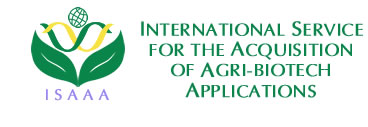ISAAA Brief 42-2010: Highlights
Highlights of "Global Status of Commercialized Biotech/GM Crops: 2010" by Clive James, Founder and Chair, ISAAA Board of Directors
Biotech Crops Surge over 1 Billion Hectares
2010 was the 15th anniversary of the commercialization of biotech crops, 1996-2010.
Accumulated hectarage from 1996 to 2010 exceeded 1 billion hectares (equivalent to the total vast area of USA or China), clearly signifying that biotech crops are here to stay.
A record 87-fold increase in hectarage between 1996 and 2010, which makes biotech crops the fastest adopted crop technology in the history of modern agriculture.
Strong double digit-growth of 10% in 2010 reaching 148 million hectares – notably, the 14 million hectare increase is the second largest increase in 15 years. “Trait hectares” grew from 180 million hectares in 2009, to 205 million hectares in 2010; an increase of 14%, or 25 million ”trait hectares”.
Number of countries planting biotech crops soared to a record 29, up from 25 in 2009 – for the first time, the top 10 countries each grew >1 million hectares. More than half the world’s population, 59% or ~4 billion people, live in the 29 countries planting biotech crops.
Three new countries, Pakistan, Myanmar and Sweden, reported planting biotech crops officially for the first time in 2010, and Germany also resumed planting.
Of the 29 biotech crop countries in 2010, 19 were developing and only 10 were industrial countries; in addition, another 30 imported biotech crop products for a total of 59 countries approving use of biotech crops, either for planting or importing; 75% of the world’s population live in the 59 countries.
In 2010, a record 15.4 million farmers grew biotech crops – notably over 90%, or 14.4 million, were small resource-poor farmers in developing countries; number of beneficiary farmers is conservative due to spill-over of benefits from biotech crops to conventional crops. Remarkably, since 1996, farmers worldwide elected to make ~100 million independent decisions to plant and replant more biotech crops every single year, because of the significant benefits they offer.
Developing countries grew 48% of global biotech crops in 2010 and will exceed industrial countries hectarage before 2015. Biotech growth rate was much faster in developing countries, 17% or 10.2 million hectares, versus 5% or 3.8 million hectares in industrial countries.
The five lead developing countries in biotech crops are China and India in Asia, Brazil and Argentina in Latin America, and South Africa on the continent of Africa.
Brazil, the engine of growth in Latin America, increased its hectarage of biotech crops, more than any other country worldwide – a record 4 million hectare increase.
In Australia, biotech crops recovered after a multi-year drought with the largest proportional year-on-year increase of 184% to reach 653,000 hectares.
Burkina Faso had the second largest proportional increase of biotech hectarage at 126%, with 80,000 farmers planting a record 260,000 hectares equivalent to a 65% adoption rate.
In Myanmar, 375,000 small farmers successfully planted 270,000 hectares of Bt cotton, equivalent to a 75% biotech adoption for all cotton grown in the country.
In India, stellar growth continued for the ninth year, with 6.3 million farmers growing 9.4 million hectares of Bt cotton, equivalent to an 86% adoption rate.
Mexico successfully conducted the first series of field trials with biotech maize.
A record eight EU countries grew either Bt maize or the “Amflora” starch potato, newly approved by the EU – the first approval for planting in 13 years in the EU.
For the first time, biotech crops occupied a substantial 10% of the ~1.5 billion hectares of global cropland; >50% of global cropland is in the 29 countries planting biotech crops in 2010.
Stacked traits are an important feature of biotech crops – 11 countries planted biotech crops with two or more traits in 2010, and 8 were developing countries – 32.2 million hectares or 22% of the 148 million hectares were stacked in 2010.
From 1996 to 2009, biotech crops contributed to Sustainability and Climate Change by: increasing crop production and value by US$65 billion; providing a better environment, by saving 393 million kg a.i. of pesticides; in 2009 alone reducing CO2 emissions by 18 billion kg, equivalent to taking ~8 million cars off the road; conserving biodiversity by saving 75 million hectares of land; and helped alleviate poverty by helping 14.4 million small farmers who are some of the poorest people in the world.
There is an urgent need for appropriate cost/time-effective regulatory systems that are responsible, rigorous but not onerous, for small and poor developing countries.
Global value of biotech seed alone was valued at US$11.2 billion in 2010, with commercial biotech maize, soybean grain and cotton valued at ~US$150 billion per year.
Future Prospects look encouraging for the next five years: drought tolerant maize in 2012; Golden Rice in 2013; and Bt rice before the MDG of 2015, to potentially benefit 1 billion poor people in rice households, in Asia alone. Biotech crops can make an enormous contribution to the 2015 MDG goal of cutting poverty in half, by optimizing crop productivity in a proposed global initiative to honor the legacy of ISAAA’s founding patron, and Nobel Peace Laureate, Norman Borlaug, who saved 1 billion people from hunger.
Detailed information is provided in ISAAA Brief 42 “Global Status of Commercialized Biotech/GM Crops: 2010”, authored by Clive James. For further information, please visit https://www.isaaa.org or contact ISAAA SEAsiaCenter at +63 49 536 7216, or email to info@isaaa.org.


